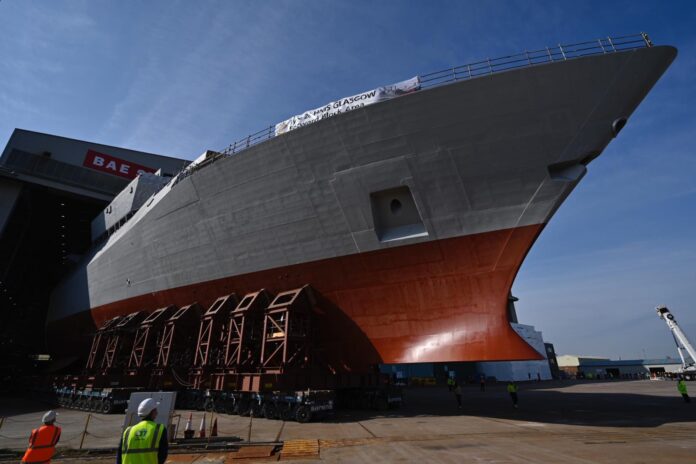The bow of HMS GLASGOW, the first City Class Type 26 frigate being built for the Royal Navy, has been rolled out of the build hall at BAE Systems shipyard on the River Clyde, BAE Systems announced.
In a move that lasted 90 minutes, the forward section of HMS GLASGOW which contains the bridge, operations room, and accommodation spaces, was maneuvered into position on the hardstand at our Govan yard where it will be joined by the aft section in the coming weeks.
HMS GLASGOW is the first in a new generation of cutting-edge Type 26 frigates, designed and built in the ship’s namesake city. Supporting more than 4,000 jobs across the UK, the program is making a significant contribution to the nation’s economic recovery by maintaining much-needed skills and capabilities. To date, more than £1bn has been invested across the program’s supply chain, with more than 100 suppliers globally.
Simon Lister, Managing Director of BAE Systems’ Naval Ships business, said: “The emergence of HMS GLASGOW is a very proud moment for everyone involved and is testament to the skills and passion of our workforce. We have now completed the construction of all units of the ship and in the coming weeks our skilled teams will bring the hull together for the first time.
“The rollout is a huge milestone for the Type 26 program. It’s evidence of our solid progress in building the first of a new class – and presents an opportunity for us to celebrate the progress being made with our colleagues, our suppliers, our customer, and the City of Glasgow.”

Pat Browning, the Type 26 programme Team Leader at Defence Equipment and Support said: “The Type 26 is a highly capable ASW warship designed for joint and multinational operations across the full spectrum of warfare and will serve at the heart of the Royal Navy’s surface fleet for decades to come.
“The roll-out of the forward section of HMS GLASGOW; the first of the Type 26 class, hails a landmark moment for this cutting-edge vessel and a huge step forward for the program. I pay tribute to the hard work and skill of all those involved in the design and manufacture of this ship and look forward to seeing the two halves of the ship coming together at BAE System’s shipyard on the Clyde in the coming weeks”.
Type 26 class frigate:
The Type 26 frigate or City-class frigate is a class of frigate being built for the United Kingdom’s Royal Navy. The programme, known as the Global Combat Ship, was launched by the UK Ministry of Defence to partially replace the navy’s thirteen Type 23 frigates, and for export. Its primary role is to conduct advanced anti-submarine warfare missions while supporting air defence and general purpose operations.
BAE Systems’ website suggests a displacement of 6,900 tonnes, a length of 149.9 m (492 ft) a beam of 20.8 m (68 ft) and a top speed in excess of 26 knots (48 km/h). The Global Combat Ship will have a core crew of 157 with room for a total of 208.[9] The Global Combat Ship is designed for up to 60 days’ endurance and a range of approximately 7,000 nautical miles (13,000 km).
The frigate will be equipped with the Type 997 Artisan 3D search radar and Sea Ceptor (CAMM) air-defense missiles launched via 48 vertical launching system (VLS) canisters. Additional 24-cell Mark 41 “strike-length VLS” cells are positioned forward of the bridge which is capable of firing missiles such as the Tomahawk land-attack cruise missile, anti-submarine rockets, a future anti-ship missile, or quad-packed ESSMs.

Like the Type 23 frigate, it will replace, the Type 26 will have an acoustically quiet hull for anti-submarine warfare and fitted with an Ultra Electronics Type 2150 next-generation bow sonar and a powerful Sonar 2087 towed array. The vessel will also be fitted with guns of various calibers. Instead of the RN’s current 4.5 inches Mark 8 naval gun, the Type 26 frigate will be equipped with a NATO-standard BAE 5 inch, 62-calibre Mark 45 naval gun. Smaller guns include two Phalanx CIWS, two 30mm DS30M Mark 2 Automated Small Calibre Guns, and a number of miniguns and general-purpose machine guns.
The propulsion system of the Type 26 class will have a gas turbine direct drive and four high-speed diesel generators driving two electric motors in a combined diesel-electric or gas (CODLOG) configuration. The Rolls Royce-made MT30 will be used in Type 26.



